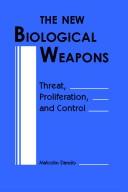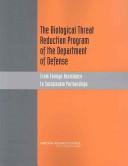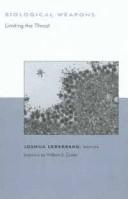| Listing 1 - 10 of 12 | << page >> |
Sort by
|
Book
ISBN: 0804786151 9780804786157 9780804782753 080478275X Year: 2012 Publisher: Stanford, California : Stanford Security Studies, an imprint of Stanford University Press,
Abstract | Keywords | Export | Availability | Bookmark
 Loading...
Loading...Choose an application
- Reference Manager
- EndNote
- RefWorks (Direct export to RefWorks)
Preventing a Biochemical Arms Race responds to a growing concern that changes in the life sciences and the nature of warfare could lead to a resurgent interest in chemical and biological weapons (CBW) capabilities. By bringing together a wide range of historical material and current literature in the field of CBW arms control, the book reveals how these two disparate fields might be integrated to precipitate a biochemical arms race among major powers, rogue states, or even non-state actors.It seeks to raise awareness among policy practitioners, the academic community, and t
Chemical arms control. --- Biological arms control. --- Biological weapons control --- Arms control --- Chemical weapons control
Book
ISBN: 1282130323 9786612130328 0309131774 9780309131773 9780309131766 0309131766 9780309137034 0309137039 0309164311 Year: 2009 Publisher: Washington, D.C. National Academies Press
Abstract | Keywords | Export | Availability | Bookmark
 Loading...
Loading...Choose an application
- Reference Manager
- EndNote
- RefWorks (Direct export to RefWorks)
Biological arms control --- Technical assistance, American. --- Bioterrorism --- American technical assistance --- Biological weapons control --- Arms control --- Government policy --- Prevention. --- Biological Threat Reduction Program (U.S.) --- United States. --- BTRP

ISBN: 1588261786 9781588261786 1555879241 9781555879242 Year: 2022 Publisher: Boulder
Abstract | Keywords | Export | Availability | Bookmark
 Loading...
Loading...Choose an application
- Reference Manager
- EndNote
- RefWorks (Direct export to RefWorks)
Current revolutions in biotechnology and neuroscience are changing military technologies, necessitating dramatic reevaluations in arms regulatory regimes. This book assesses how these new technologies can be used in weapons systems—by governments and terrorists alike—and whether this frightening development can be brought under effective international control. Dando begins by surveying the existing (and arguably inadequate) control mechanisms for chemical and biological weapons. He then discusses how earlier generations of toxin and bioregulatory weapons have been developed by such states as Iraq, the former Soviet Union, and the U.S. and explains, in nontechnical terms, the scientific advances that have implications for new weapons technology. Considering how international law might be applied to constrain undesirable military developments without restricting technological developments for peaceful purposes, Dando concludes with a proposal for an integrated control regime that would link international agreements, national legislation, and trade regulations.
Biological weapons. --- Biological arms control. --- Biological weapons control --- Arms control --- Bacteriological weapons --- Biological warfare agents --- Bioweapons --- Weapons of mass destruction --- Biosecurity

ISBN: 1281093564 9786611093563 0309111595 9780309111591 0309111587 9780309111584 0309179513 Year: 2007 Publisher: Washington, D.C. National Academies Press
Abstract | Keywords | Export | Availability | Bookmark
 Loading...
Loading...Choose an application
- Reference Manager
- EndNote
- RefWorks (Direct export to RefWorks)
Biological arms control. --- Biological weapons --- Bioterrorism --- Biological warfare --- Bacterial warfare --- Bacteriological warfare --- Biowarfare --- CBR warfare --- Disease warfare --- Germ warfare --- Pathogenic bacteria --- Bioengineering --- War --- Bacteriological weapons --- Biological warfare agents --- Bioweapons --- Weapons of mass destruction --- Biosecurity --- Biological weapons control --- Arms control --- Research --- Safety measures. --- Prevention. --- War use --- Biological Threat Reduction Program (U.S.) --- United States. --- BTRP --- Cold War Biological warfare

ISBN: 0262272970 0585208069 9780585208060 026206183X 026256095X Year: 1995 Publisher: Cambridge, Mass. MIT Press
Abstract | Keywords | Export | Availability | Bookmark
 Loading...
Loading...Choose an application
- Reference Manager
- EndNote
- RefWorks (Direct export to RefWorks)
This primer provides a complete yet concise overview of the technicalbackground needed to understand today's nonproliferation issues. It describes allthe existing types of weapons of mass destruction and examines the threats they poseand their implications for regional and international security.The authors identifycountries that have, or may have, programs to develop such weapons, describe thetechnology needed to continue such programs, and examine the extent to which theseprograms violate existing international agreements. They also outline existingunilateral and multilateral measures designed to curb proliferation and discuss newmeasures that could strengthen current nonproliferation efforts.
Biological arms control --- Chemical arms control --- Nuclear nonproliferation --- #SBIB:327.5H22 --- Export of nuclear materials --- Export of nuclear technology --- International control of nuclear energy --- Nonproliferation, Nuclear --- Nuclear energy --- Nuclear exports --- Nuclear proliferation --- Proliferation, Nuclear --- Nuclear arms control --- Nuclear-weapon-free zones --- Chemical weapons control --- Arms control --- Biological weapons control --- Ontwapeningsproblemen - bewapening --- International control --- International Relations --- Political Science
Book
ISBN: 0804779813 9780804779814 9780804759762 9780804759779 0804759774 Year: 2008 Publisher: Stanford, Calif. Stanford University Press
Abstract | Keywords | Export | Availability | Bookmark
 Loading...
Loading...Choose an application
- Reference Manager
- EndNote
- RefWorks (Direct export to RefWorks)
Terrorism, War, or Disease? Unraveling the Use of Biological Weapons examines the complex political, military, legal, and scientific challenges involved in determining when biological weapons have been and who has used them through detailed case studies and draws lessons to improve our ability to counter the world's most deadly silent killers.
Biological weapons --- Biological arms control. --- National security. --- National security --- National security policy --- NSP (National security policy) --- Security policy, National --- Economic policy --- International relations --- Military policy --- Biological weapons control --- Arms control --- Bacteriological weapons --- Biological warfare agents --- Bioweapons --- Weapons of mass destruction --- Biosecurity --- Government policy. --- Government policy
Book
ISBN: 0674070232 0674065263 9780674065260 9780674047709 0674047702 9780674070233 Year: 2012 Publisher: Cambridge, MA
Abstract | Keywords | Export | Availability | Bookmark
 Loading...
Loading...Choose an application
- Reference Manager
- EndNote
- RefWorks (Direct export to RefWorks)
Russian officials claim today that the USSR never possessed an offensive biological weapons program. In fact, the Soviet government spent billions of rubles and hard currency to fund hugely expensive research that added nothing to the country's security. This history is the first attempt to understand the full scope of the USSR's offensive biological weapons research-its inception in the 1920's, its growth between 1970 and 1980, and its possible remnants in present-day Russia. We learn that between 1990 and 1992 the U.S. and U.K. governments never obtained clear evidence of the program's closure, raising the haunting question whether the means for waging biological warfare could be resurrected in Russia today. Based on interviews with important Soviet scientists and managers, papers from the Soviet Central Committee, and U.S. and U.K. declassified documents, this book peels back layers of lies, to reveal how and why Soviet leaders decided to develop biological weapons, the scientific resources they dedicated to this task, and the multitude of research institutes that applied themselves to its fulfillment. We learn that Biopreparat, an ostensibly civilian organization, was established to manage a top secret program, code-named Ferment, whose objective was to apply genetic engineering to develop strains of pathogenic agents that had never existed in nature. Leitenberg and Zilinskas consider the performance of the U.S. intelligence community in discovering and assessing these activities, and they examine in detail the crucial years 1985 to 1992, when Mikhail Gorbachev's attempts to put an end to the program were thwarted.
Biological weapons --- Biological warfare --- Biological arms control --- Biological weapons control --- Arms control --- Bacterial warfare --- Bacteriological warfare --- Biowarfare --- CBR warfare --- Disease warfare --- Germ warfare --- Pathogenic bacteria --- Bioengineering --- War --- Bacteriological weapons --- Biological warfare agents --- Bioweapons --- Weapons of mass destruction --- Biosecurity --- History. --- War use --- Cold War Biological warfare

ISBN: 0262621282 0585077452 9780585077451 0262122162 9780262278058 0262278057 9780262122160 9780262621281 Year: 1999 Volume: *3 Publisher: Cambridge, Mass MIT Press
Abstract | Keywords | Export | Availability | Bookmark
 Loading...
Loading...Choose an application
- Reference Manager
- EndNote
- RefWorks (Direct export to RefWorks)
foreword by William S. Cohen, U.S. Secretary of Defense Biological weapons pose a horrifying and growing threat to the United States and to the world in general. Revelations about Iraq's weapons research and the plans of the Aum Shinrikyo cult in Japan serve as frightening reminders of the potential for military or terrorist use of biological agents. The essays in this book, many of which were originally published in the Journal of the American Medical Association, examine the medical, scientific, and political dimensions of limiting the threat posed by biological weapons. The contributors consider the current threat posed by biological weapons, the history of attempts to control them, episodes in which biological agents have been used, Iraq's biological warfare program, and policies that the United States might pursue to reduce the threat.ContributorsSuzanne Barth, Pamela Berkowsky, Kristin A. Birkness, Stephen Black, W. Russell Byrne, W. Seth Carus, Marie Chevrier, George W. Christopher, Theodore J. Cieslak, Richard Danzig, Edward M. Eitzen, Jr., Charles C. Engel, James R. Ferguson, Laurence R. Foster, David R. Franz, Arthur M. Friedlander, Carol S. Fullerton, Jeanne Guillemin, Charles E. Haley, Harry C. Holloway, David L. Hoover, John M. Horan, Martin Hugh-Jones, Peter B. Jahrling, Robert P. Kadlec, Akiko Kimura, Shellie A. Kolavic, Alexander Langmuir, John R. Livengood, Karl Lowe, Steven Mauvais, David J. McClain, Matthew Meselson, Ann E. Norwood, Julie A. Pavlin, Graham S. Pearson, Ilona Popova, Alexis Shelokov, Jeffrey D. Simon, Shauna L. Simons, Michael R. Skeels, Laurence Slutsker, Robert Sokolow, Robert V. Tauxe, Thomas J. T r k, Jonathan B. Tucker, Robert J. Ursano, Victor Utgoff, Ann M. Vrtis, Robert P. Wise, Olga Yampolskaya, Allan P. Zellicoff, Raymond A. Zilinskas
Biological arms control. --- Biological weapons. --- Armes biologiques --- Armes biologiques [Limitation des ] --- Bacteria [Pathogenic ]--War use --- Bacterial warfare --- Bacteriological warfare --- Bacteriologische oorlog --- Biological arms control --- Biological warfare --- Biological weapons --- Biological weapons control --- Biologische oorlogvoering --- Biologische wapens --- Biologische wapens--Wapenbeheersing --- Biowarfare --- CBR warfare --- Disease warfare --- Germ warfare --- Guerre bactériologique --- Guerre biologique --- Limitation des armes biologiques --- Oorlogvoering [Biologische ] --- Pathogenic bacteria--War use --- Wapens [Biologische ] --- Weapons [Biological ] --- United States --- Military policy --- Biological Warfare --- History --- Political Science
Book

ISBN: 0833089765 9780833089762 9780833086938 0833086936 Year: 2014 Publisher: Santa Monica, CA RAND
Abstract | Keywords | Export | Availability | Bookmark
 Loading...
Loading...Choose an application
- Reference Manager
- EndNote
- RefWorks (Direct export to RefWorks)
"The Cooperative Biological Engagement Program (CBEP) is the biological threat component of the Cooperative Threat Reduction program. It grew out of efforts to address risks associated with legacy biological agents, related materials, and technical expertise developed as part of the biological weapon program in the former Soviet Union. CBEP now partners with about 20 countries in different regions around the world and works with them to address diverse threats to international security, including terrorist organizations seeking to acquire pathogens of security concern; human, animal, and agricultural facilities operating with inadequate safety and security safeguards; and the spread of diseases with potential security or economic consequences. As the program has evolved since its inception two decades ago, so too have its content and approaches to performance measurement. The objective of the research reported here was to build on existing work to develop a comprehensive evaluation framework and recommend metrics for assessing and communicating progress toward CBEP's goals. The report ultimately recommends a number of qualitative and quantitative indicators of CBEP performance, some that can be implemented immediately, some to be implemented later"--
Biosecurity --- Biological arms control --- Public health surveillance --- Public Health --- Law, Politics & Government --- Health & Biological Sciences --- Epidemiology & Epidemics --- International Relations --- Evaluation --- Population surveillance (Public health) --- Surveillance, Public health --- Biological weapons control --- Epidemiology --- Arms control --- Human security --- Biological weapons --- Communicable diseases --- Public health --- Safety measures --- Prevention --- Cooperative Biological Engagement Program (U.S.) --- CBEP (Cooperative Biological Engagement Program (U.S.)) --- United States. --- Center for Disaster and Humanitarian Assistance Medicine (U.S.)
Book
ISBN: 1626164053 9781626164055 9781626164048 Year: 2017 Publisher: Washington, DC
Abstract | Keywords | Export | Availability | Bookmark
 Loading...
Loading...Choose an application
- Reference Manager
- EndNote
- RefWorks (Direct export to RefWorks)
Biosecurity Dilemmas examines conflicting values and interests in the practice of "biosecurity," the safeguarding of populations against infectious diseases through security policies. Biosecurity encompasses both the natural occurrence of deadly disease outbreaks and the deliberate or accidental release of biological weapons. Enemark focuses on six dreaded diseases that are given high-priority by governments and international organizations for research, regulation, surveillance, and rapid response: pandemic influenza, drug-resistant tuberculosis, smallpox, Ebola virus, bubonic plague, and anthrax. The book is organized around four ethical dilemmas that arise when fear causes these diseases to be framed in terms of national or international security: protect or proliferate, secure or stifle, remedy or overkill, and attention or neglect. For instance, will prioritizing research into defending against a rare event such as a bioterrorist attack divert funds away from research into commonly occurring diseases? Or will securitizing a particular disease actually stifle research progress due to security classification measures? Enemark provides a comprehensive analysis of the ethics of securitizing disease and explores ideas and policy recommendations about biological arms control, global health security, and public health ethics.
National security. --- Public health --- Biological arms control. --- Communicable diseases. --- Bioterrorism --- Biosecurity --- Biosecurity. --- Human security --- Biological weapons --- Communicable diseases --- Contagion and contagious diseases --- Contagious diseases --- Infectious diseases --- Microbial diseases in human beings --- Zymotic diseases --- Diseases --- Infection --- Epidemics --- Biological weapons control --- Arms control --- National security --- National security policy --- NSP (National security policy) --- Security policy, National --- Economic policy --- International relations --- Military policy --- Moral and ethical aspects. --- Prevention. --- Safety measures --- Prevention --- Government policy
| Listing 1 - 10 of 12 | << page >> |
Sort by
|

 Search
Search Feedback
Feedback About UniCat
About UniCat  Help
Help News
News